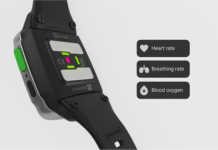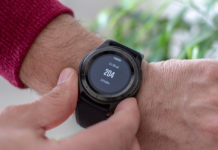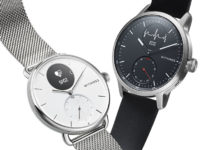I participated in a Startup Accelerator taught by UC Berkeley. The first thing they drill into your head is, “Most start-ups fail than succeeded.” There are three reasons for this: 1. Poor product idea aka there is no market 2. Bad team relations 3. Not enough resources. Wearables is a challenging industry to pop yourself into. It is new which means a lot of the resources are not ready for mass manufacturing. Even so, another piece of wisdom that was drilled into my way of thinking is: YOU ARE THE ENTREPRENEUR – YOU MUST FIND A SOLUTION. Truthfully, one of the best solutions is swimming back to land before you run out of energy and begin to sink. There are a several companies that we have liked very much and which ideas we supported; yet they began to sink and were forced to abandon ship.

- Cuff spoke at our WT | Wearable Technologies Conference 2014 USA. They thrilled the audience with their emergency call plus notification information on jewelry. The idea is you have a plastic part of the jewelry that can be interchangeable between necklaces and bracelets. Their goal was to ensure that women, and people who like wearing jewelry, have a safety net to send their GPS locations to when they are feeling threatened. On top of that, your jewelry will vibrate in various patterns if you get a phone call, email or text. Cuff was a wearable celebrity for a while; featured in Good Morning America, New York Times, Tech Crunch. They are even selling their product at Target. Yet, we received a bad review to our contact list saying that they never sent their backers a product..? Not sure what to make of this rumor as we are still hoping for an official statement from Cuff.
![Elbee[1]](https://www.wearable-technologies.com/wp-content/uploads/2015/04/Elbee1-300x199.jpg)
- Sometimes the best way to recognize that there is no market for your product is to launch a crowdfunding campaign. Elbee was thought of as wireless headphones that could change the music through haptic feedback of moving your head a particular way. This intrigued investors and a handful of folks who wished to work on the project. However, their Kickstarter was a fail; leading the CEO and co-founders to find another path for their expertise to be put to use.
- A similar story goes for company called Gest. They created an interactive remote that connects to each of your fingers. The idea was to allow you to type wirelessly to any devices from any surface. Cool, right? People thought so too, for they hosted a successful Kickstarter in November of 2015. However, by April 2016 they announced they needed more money for production and delivery to all their backers. Unable to obtain it, they sent re-funds to everyone. This brings up a good point. Just because a company has a successful crowd funding campaign, doesn’t mean that they are successful in the long-run. Usually, they only get enough money to produce and deliver enough product for their backers. Thus, becoming more of a beta test than a growing start-up. Be wise in the amount of money you are requesting. For you want to remain a player in the field well beyond your campaign.
Those that are wise will take the chance to pivot in the direction of sunshine. They can foresee the future and weigh the pros and cons of continuing to work on something that no one really wants. This is not an easy step for a lot of people. Egos, stubborn minds, limited resources, and dishonesty are a few reasons why companies do not change. Beware, for pivoting can be the best decision a team has ever made. Beyond industry, is it ethical to create a product that is essentially landfill (one of my personal questions that I ask every time I walk around a big department store)? Find a few companies that have changed their product in order to fulfill their vision.
- AmpStrip is a smart patch that was originally designed for fitness. They gain much support on their crowd funding campaign and won the CES2015 Innovation Award. However, on their website they state that they received feedback from their customers that they should be a medical patch; which means back to the drawing board. They are re-funding all of their backers and have begun the process of medical approval. This is a much longer process than monitoring devices, in terms of enter a consumer market. The regulations are more limited to what materials are safe for the body and the extend of accuracy. I am personally excited to see how their product evolves.
- In 2014, a company called RingBlingz came out with an idea for a wearable for teenagers.
 Seems ideal, you are creating a tech device for people who have lived their whole lives with tech. The idea was for their ring to alter them when they have a notification on their phone. The inside scoop is it also has a GPS tracking function that allows parents to see where their child is. To me, it seems like the market wasn’t quite ready for them, because when you visit their website (now in 2016) you are looking at an empty page that says “Future Home of Something Quite Cool.” Wonder what that could be….
Seems ideal, you are creating a tech device for people who have lived their whole lives with tech. The idea was for their ring to alter them when they have a notification on their phone. The inside scoop is it also has a GPS tracking function that allows parents to see where their child is. To me, it seems like the market wasn’t quite ready for them, because when you visit their website (now in 2016) you are looking at an empty page that says “Future Home of Something Quite Cool.” Wonder what that could be…. - In April of 2015 is when Trellie said their smart costume jewelry would be ready for market. The problem they faced is competition with bigger and more established companies. They have patents and IP on their technology. The team and their stock holders decided to pivoted their product to the backend of the product. Instead of selling to the consumer, they will sell to other businesses. Sounds like a solid plan if you ask me.
- Movo is a a smart activity tracker, that stand out from its compeditors by being customizable. They enter the market in 2014, yet as of recent there has been minimal activty. When we searched on LinkedIn, we found an offical statement from CEO, Mark Tanner, stating that they no longer have to resources to conduct their work. With the experience and support they are sure that they did well for the 2 years they were active in the market. However, it is hard to be a small fish in the big ocean of tech giants. Perhaps there will be something super cool up-in-coming for the teams future?
A quick note about Movo https://t.co/TUIR19jOty pic.twitter.com/GO2pCw4EuQ
— Mark Tanner (@TarkManner) March 11, 2016
Make sure you are making informed and highly researched choices about your company and product. As my mentors said, “Get out of the office and conduct customer interviews!” There are already way too many choices of cereal to choose from in the grocery store, and the truth is they are all sugar and corn – nothing good for you. I highly suggest to not be a box of cereal sitting on the shelf for ages, and mostly, do not create a piece of technology that will end up as trash. Take your time – yet move with the winds. You are the captain of the ship and the tides are changing.
Questions about how to remain afloat? Contact us for tailor-made consulting services.

















